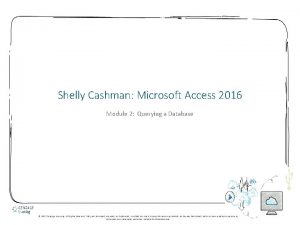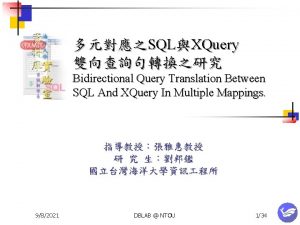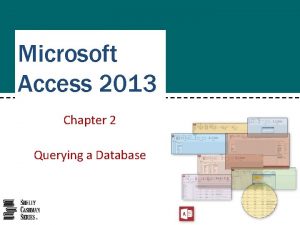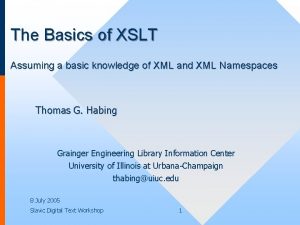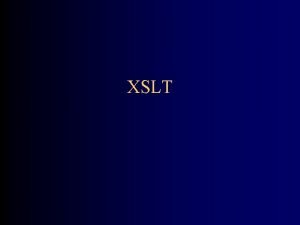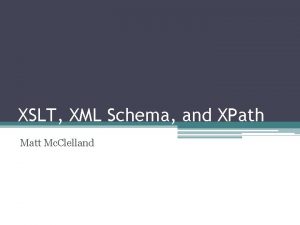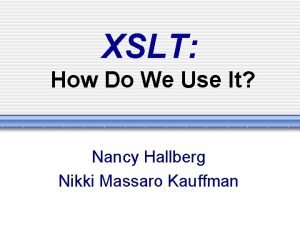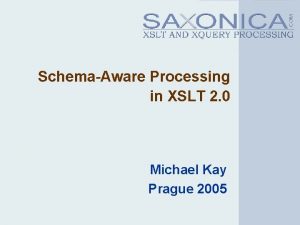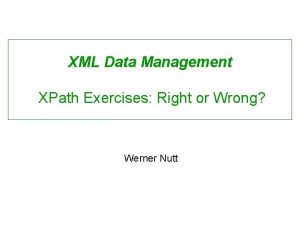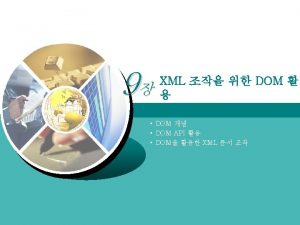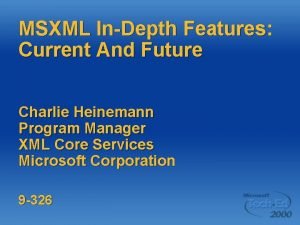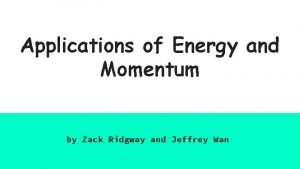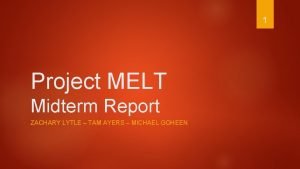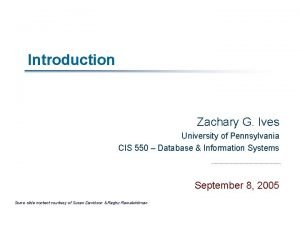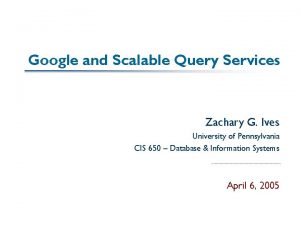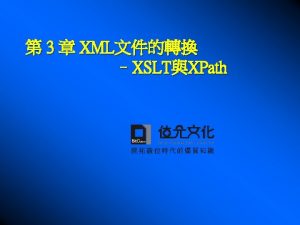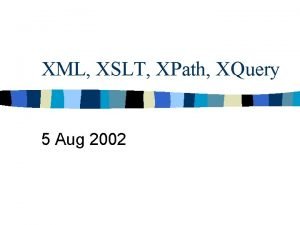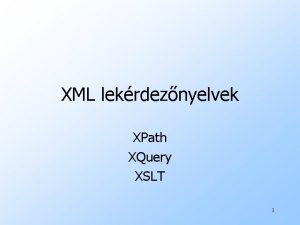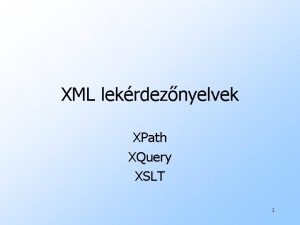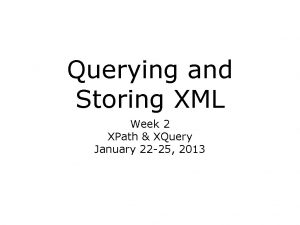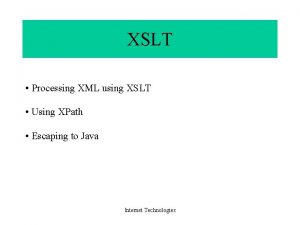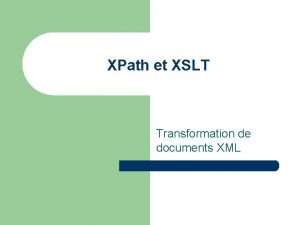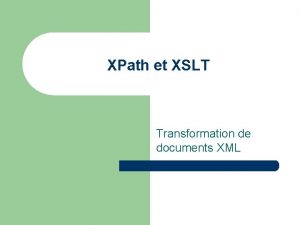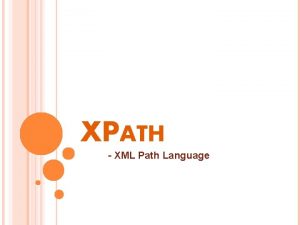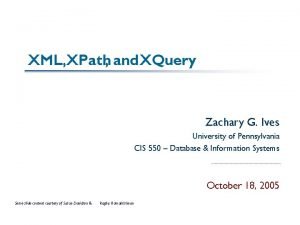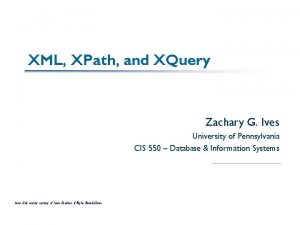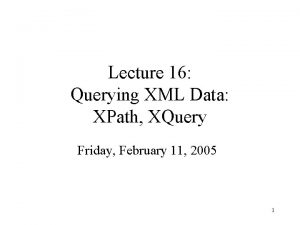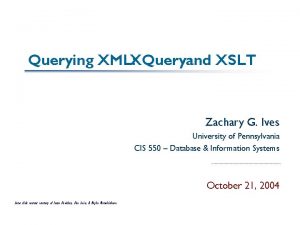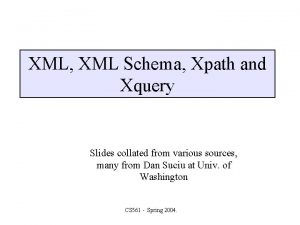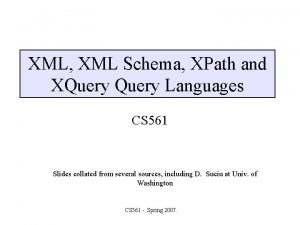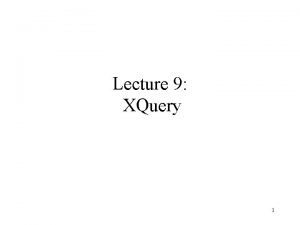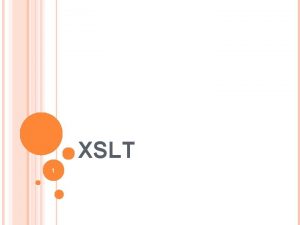Querying XML XPath XQuery and XSLT Zachary G





































- Slides: 37

Querying XML: XPath, XQuery, and XSLT Zachary G. Ives University of Pennsylvania CIS 550 – Database & Information Systems October 27, 2005 Some slide content courtesy of Susan Davidson, Dan Suciu, & Raghu Ramakrishnan

Reminders § Homework 4 due 11/3 § XQuery § Project plan due 11/3 § Milestones § Division of responsibilities § For non-RSS projects: proposal including scope, milestones, and what you plan to demonstrate § Recitation: Friday 11: 30 -12: 30, Levine 512 2

Talks of Interest Today: § Anastassia Ailamaki, CMU, “FATES: Automatically-tuned Database Storage Management ”, IRCS (3401 Walnut) Room 470 @ 3 PM Tomorrow as part of “DB & Information Retrieval Day”: § Anastassia Ailamaki, CMU, “Staged. DB : Designing Database Servers for New Hardware Trends ”, Wu and Chen @ 11 AM § Sam Madden, MIT, “Data Management for Next Generation Wireless Sensor Networks ”, Wu and Chen @ 12: 30 PM § Andrei Broder, Yahoo!, “The next stage in Web IR: From query based Information Retrieval to context driven Information Supply ”, Wu and Chen @ 2: 30 PM 3

Querying XML How do you query a directed graph? a tree? The standard approach used by many XML, semistructured-data, and object query languages: § Define some sort of a template describing traversals from the root of the directed graph § In XML, the basis of this template is called an XPath 4

XPaths In its simplest form, an XPath is like a path in a file system: /mypath/subpath/*/morepath § The XPath returns a node set representing the XML nodes (and their subtrees) at the end of the path § XPaths can have node tests at the end, returning only particular node types, e. g. , text(), processing-instruction(), comment(), element(), attribute() § XPath is fundamentally an ordered language: it can query in order-aware fashion, and it returns nodes in order 5

Sample XML <? xml version="1. 0" encoding="ISO-8859 -1" ? > <dblp> <mastersthesis mdate="2002 -01 -03" key="ms/Brown 92"> <author>Kurt P. Brown</author> <title>PRPL: A Database Workload Specification Language</title> <year>1992</year> <school>Univ. of Wisconsin-Madison</school> </mastersthesis> <article mdate="2002 -01 -03" key="tr/dec/SRC 1997 -018"> <editor>Paul R. Mc. Jones</editor> <title>The 1995 SQL Reunion</title> <journal>Digital System Research Center Report</journal> <volume>SRC 1997 -018</volume> <year>1997</year> <ee>db/labs/dec/SRC 1997 -018. html</ee> <ee>http: //www. mcjones. org/System_R/SQL_Reunion_95/</ee> </article> 6

XML Data Model Visualized Root ? xml 2002… element article mdate author title year school 1992 key editor title journal volume year ee ee 2002… tr/dec/… PRPL… Kurt P…. p-i dblp key ms/Brown 92 attribute text mastersthesis mdate root Digital… Univ…. 1997 The… Paul R. db/labs/dec SRC… http: //www. 7

Some Example XPath. Queries § § /dblp/mastersthesis/title /dblp/*/editor //title/text() 8

Context Nodes and Relative Paths XPath has a notion of a context node: it’s analogous to a current directory § “. ” represents this context node § “. . ” represents the parent node § We can express relative paths: subpath/sub-subpath/. . gets us back to the context node Ø By default, the document root is the context node 9

Predicates – Selection Operations A predicate allows us to filter the node set based on selection-like conditions over sub-XPaths: /dblp/article[title = “Paper 1”] which is equivalent to: /dblp/article[. /title/text() = “Paper 1”] 10

Axes: More Complex Traversals Thus far, we’ve seen XPath expressions that go down the tree (and up one step) § But we might want to go up, left, right, etc. § These are expressed with so-called axes : self: : path-step child: : path-step descendant-or-self: : path-step preceding-sibling: : path-step preceding: : path-step parent: : path-step ancestor-or-self: : path-step following-sibling: : path-step following: : path-step § The previous XPaths we saw were in “abbreviated form” 11

Querying Order § We saw in the previous slide that we could query for preceding or following siblings or nodes § We can also query a node for its position according to some index: § fn: first() , fn: last() return index of 0 th & last element matching the last step: § fn: position() gives the relative count of the current node child: : article[fn: position() = fn: last()] 12

Users of. XPath § XML Schema uses simple XPaths in defining keys and uniqueness constraints § XQuery § XSLT § XLink and XPointer, hyperlinks for XML 13

XQuery A strongly-typed, Turing-complete XML manipulation language § Attempts to do static typechecking against XML Schema § Based on an object model derived from Schema Unlike SQL, fully compositional, highly orthogonal: § Inputs & outputs collections (sequences or bags) of XML nodes § Anywhere a particular type of object may be used, may use the results of a query of the same type § Designed mostly by DB and functional language people Attempts to satisfy the needs of data management and document management § The database-style core is mostly complete (even has support for NULLs in XML!!) § The document keyword querying features are still in the works – shows in the order-preserving default model 14

XQuery’s. Basic Form § Has an analogous form to SQL’s SELECT. . FROM. . WHERE. . GROUP BY. . ORDER BY § The model: bind nodes (or node sets) to variables; operate over each legal combination of bindings; produce a set of nodes § “FLWOR” statement [note case sensitivity!]: for {iterators that bind variables} let {collections} where {conditions} order by {order-conditions} (older version was “SORTBY”) return {output constructor} 15

“Iterations” in XQuery A series of (possibly nested) FOR statements assigning the results of XPaths to variables for $root in document(“http: //my. org/my. xml”) for $sub in $root/root. Element, $sub 2 in $sub/sub. Element, … § Something like a template that pattern-matches, produces a “binding tuple” § For each of these, we evaluate the WHERE and possibly output the RETURN template § document() or doc() function specifies an input file as a URI § Old version was “document”; now “doc” but it depends on your XQuery implementation 16

Two XQuery. Examples <root-tag> { for $p in document(“dblp. xml”)/dblp/proceedings, $yr in $p/yr where $yr = “ 1999” return <proc> {$p} </proc> } </root-tag> for $i in document(“dblp. xml”)/dblp/inproceedings[author/text() = “John Smith”] return <smith-paper> <title>{ $i/title/text() }</title> <key>{ $i/@key }</key> { $i/crossref } </smith-paper> 17

Nesting in. XQuery Nesting XML trees is perhaps the most common operation In XQuery, it’s easy – put a subquery in the return clause where you want things to repeat! for $u in document(“dblp. xml”)/universities where $u/country = “USA” return <ms-theses-99> { $u/title } { for $mt in $u/. . /mastersthesis where $mt/year/text() = “ 1999” and ______ return $mt/title } </ms-theses-99> 18

Collections & Aggregation XQuery in In XQuery, many operations return collections § XPaths, sub-XQueries, functions over these, … § The let clause assigns the results to a variable Aggregation simply applies a function over a collection, where the function returns a value (very elegant!) let $allpapers : = document(“dblp. xml”)/dblp/article return <article-authors> <count> { fn: count(fn: distinct-values($allpapers/authors)) } </count> { for $paper in doc(“dblp. xml”)/dblp/article let $pauth : = $paper/author return <paper> {$paper/title} <count> { fn: count($pauth) } </count> </paper> } </article-authors> 19

Collections, Ctd. Unlike in SQL, we can compose aggregations and create new collections from old: <result> { let $avg. Items. Sold : = fn: avg( for $order in document(“my. xml”)/orders/order let $total. Sold = fn: sum($order/item/quantity) return $total. Sold) return $avg. Items. Sold } </result> 20

Distinct-ness In XQuery, DISTINCT-ness happens as a function over a collection § But since we have nodes, we can do duplicate removal according to value or node § Can do fn: distinct-values(collection) to remove duplicate values, or fn: distinct-nodes(collection) to remove duplicate nodes for $years in fn: distinct-values(doc(“dblp. xml”)//year/text() return $years 21

Sorting in. XQuery § SQL actually allows you to sort its output, with a special ORDER BY clause (which we haven’t discussed, but which specifies a sort key list) § XQuery borrows this idea § In XQuery, what we order is the sequence of “result tuples” output by the return clause: for $x in document(“dblp. xml”)/proceedings order by $x/title/text() return $x 22

What If Order Doesn’t Matter? By default: § SQL is unordered § XQuery is ordered everywhere! § But unordered queries are much faster to answer XQuery has a way of telling the query engine to avoid preserving order: § unordered { for $x in (mypath) … } 23

Querying & Defining Metadata – Can’t Do This in SQL Can get a node’s name by querying node-name(): for $x in document(“dblp. xml”)/dblp/* return node-name($x) Can construct elements and attributes using computed names: for $x in document(“dblp. xml”)/dblp/*, $year in $x/year, $title in $x/title/text(), element node-name($x) { attribute {“year-” + $year} { $title } } 24

XQuery. Summary Very flexible and powerful language for XML § Clean and orthogonal: can always replace a collection with an expression that creates collections § DB and document-oriented (we hope) § The core is relatively clean and easy to understand Turing Complete – we’ll talk more about XQuery functions soon 25

XSL(T): The Bridge Back to HTML § XSL (XML Stylesheet Language) is actually divided into two parts: § XSL: FO: formatting for XML § XSLT: a special transformation language § We’ll leave XSL: FO for you to read off www. w 3. org, if you’re interested § XSLT is actually able to convert from XML HTML, which is how many people do their formatting today § Products like Apache Cocoon generally translate XML HTML on the server side 26

A Different Style of Language § XSLT is based on a series of templates that match different parts of an XML document § There’s a policy for what rule or template is applied if more than one matches (it’s not what you’d think!) § XSLT templates can invoke other templates § XSLT templates can be nonterminating (beware!) § XSLT templates are based on XPath “match”es, and we can also apply other templates (potentially to “select”ed XPaths) § Within each template, we describe what should be output § (Matches to text default to outputting it) 27

An XSLTStylesheet <xsl: stylesheet version=“ 1. 1”> <xsl: template match=“/dblp”> <html><head>This is DBLP</head> <body> <xsl: apply-templates /> </body> </html> </xsl: template> <xsl: template match=“inproceedings”> <h 2><xsl: apply-templates select=“title” /></h 2> <p><xsl: apply-templates select=“author”/></p> </xsl: template> … </xsl: stylesheet> 28

Results of XSLTStylesheet <dblp> <inproceedings> <title>Paper 1</title> <author>Smith</author> </inproceedings> <author>Chakrabarti</author> <author>Gray</author> <title>Paper 2</title> </inproceedings> </dblp> <html><head>This Is DBLP</head> <body> <h 2>Paper 1</h 2> <p>Smith</p> <h 2>Paper 2</h 2> <p>Chakrabarti</p> <p>Gray</p> </body> </html> 29

What XSLT Can and Can’t Do § XSLT is great at converting XML to other formats § XML diagrams in SVG; HTML; La. Te. X § … § XSLT doesn’t do joins (well), it only works on one XML file at a time, and it’s limited in certain respects § It’s not a query language, really § … But it’s a very good formatting language § Most web browsers (post Netscape 4. 7 x) support XSLT and XSL formatting objects § But most real implementations use XSLT with something like Apache Cocoon § You may want to use XSL/XSLT for your projects – see www. w 3. org/TR/xslt for the spec 30

Querying XML We’ve seen three XML manipulation formalisms today: § XPath: the basic language for “projecting and selecting” (evaluating path expressions and predicates) over XML § XQuery: a statically typed, Turing-complete XML processing language § XSLT: a template-based language for transforming XML documents § Each is extremely useful for certain applications! 31

Views in SQL and XQuery § A view is a named query § We use the name of the view to invoke the query (treating it as if it were the relation it returns) Using the views: SQL: SELECT * CREATE VIEW V(A, B, C) AS FROM V, R SELECT A, B, C FROM R WHERE R. A = “ 123” WHERE V. B = 5 AND V. C = R. C XQuery: declare function V() as element(content)* { for $v in V()/content, for $r in doc(“R”)/root/tree, $r in doc(“r”)/root/tree $a in $r/a, $b in $r/b, $c in $r/c where $v/b = $r/b where $a = “ 123” return $v return <content>{$a, $b, $c}</content> } 32

What’s Useful about Views Providing security/access control § We can assign users permissions on different views § Can select or project so we only reveal what we want! Can be used as relations in other queries § Allows the user to query things that make more sense Describe transformations from one schema (the base relations) to another (the output of the view) § The basis of converting from XML to relations or vice versa § This will be incredibly useful in data integration, discussed soon… Allow us to define recursive queries 33

Materialized vs. Virtual Views § A virtual view is a named query that is actually re-computed every time – it is merged with the referencing query CREATE VIEW V(A, B, C) AS SELECT A, B, C FROM R WHERE R. A = “ 123” SELECT * FROM V, R WHERE V. B = 5 AND V. C = R. C § A materialized view is one that is computed once and its results are stored as a table § § Think of this as a cached answer These are incredibly useful! Techniques exist for using materialized views to answer other queries Materialized views are the basis of relating tables in different schemas 34

Views Should Stay Fresh § Views (sometimes called intensional relations ) behave, from the perspective of a query language, exactly like base relations (extensional relations) § But there’s an association that should be maintained: § If tuples change in the base relation, they should change in the view (whether it’s materialized or not) § If tuples change in the view, that should reflect in the base relation(s) 35

View Maintenance and the View Update Problem § There exist algorithms to incrementally recompute a materialized view when the base relations change § We can try to propagate view changes to the base relations § However, there are lots of views that aren’t easily updatable: R B C R⋈S A B C 1 2 2 4 1 2 4 2 2 2 3 1 2 3 A B S delete? 2 2 4 § We can ensure views are updatable by enforcing certain constraints (e. g. , no aggregation), 2 2 3 but this limits the kinds of views we can have! 36

Next Time § Can we have views in XML over tables in relations? § … Or vice versa? § What other things can we use views for 37
 Xquery vs xslt
Xquery vs xslt Nnn side xxl
Nnn side xxl Access module 2 querying a database
Access module 2 querying a database Xquery injection
Xquery injection Access module 2 querying a database
Access module 2 querying a database Xquery distinct
Xquery distinct Flukeout answers
Flukeout answers Position() in xslt
Position() in xslt What is language
What is language Xsd vs xslt
Xsd vs xslt Nnn stands for
Nnn stands for Xslt
Xslt Michael kay xslt
Michael kay xslt Xpath exercises
Xpath exercises Xpath visualizer
Xpath visualizer Xpath root
Xpath root Xml
Xml Org.apache.xpath.xpathapi
Org.apache.xpath.xpathapi Xpath beispiele
Xpath beispiele Msxml xpath
Msxml xpath Zachary rothschild
Zachary rothschild The story of the triangle factory fire by zachary kent
The story of the triangle factory fire by zachary kent Zachary omohundro
Zachary omohundro Zachary youth park field map
Zachary youth park field map Zachary ridgway
Zachary ridgway Zachary ho
Zachary ho Zachary sprague
Zachary sprague Lytle pronunciation
Lytle pronunciation Zack ives
Zack ives Zachary ivey
Zachary ivey Zach pascoe
Zach pascoe Zachary schutzman
Zachary schutzman Berquist sherman method
Berquist sherman method Zachary jacobson
Zachary jacobson Zachary kurmas
Zachary kurmas Randy liang
Randy liang Usda people's garden
Usda people's garden Convert image to word
Convert image to word


